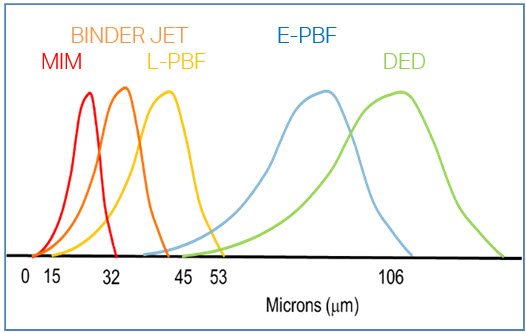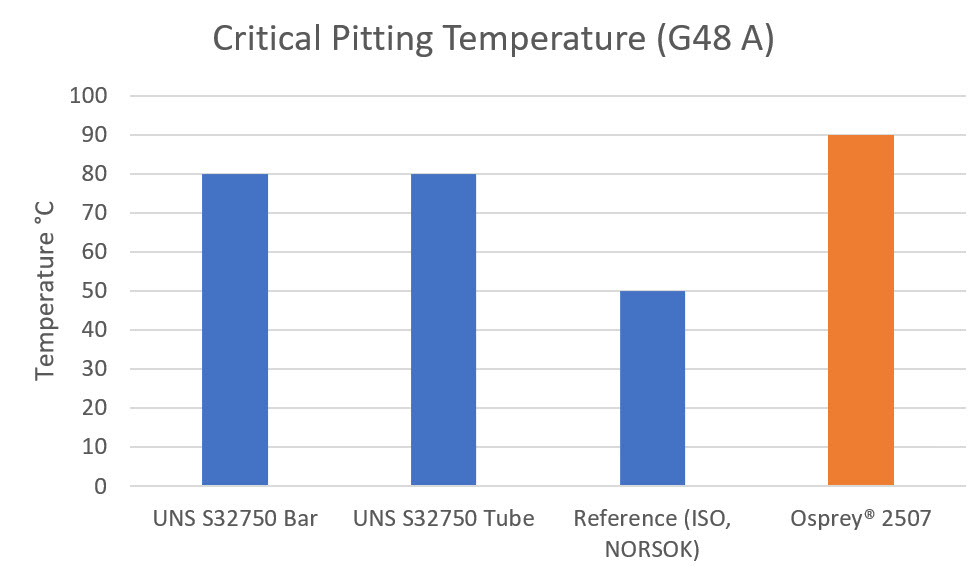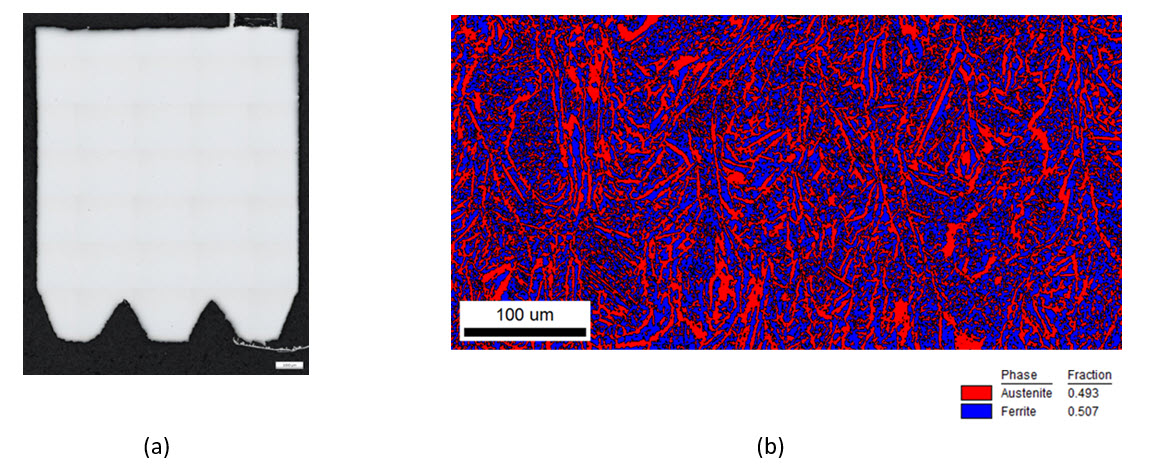Material data: Osprey® 2507 super-duplex stainless steel
General description
Osprey® 2507 is a super-duplex (austenitic-ferritic) stainless steel powder manufactured by inert gas atomization. The alloy is characterized by, for example:
- Excellent corrosion resistance in chloride environments (PREN~ 43)
- Excellent mechanical properties
- High resistance to general corrosion
Osprey® 2507 metal powder is available in a range of customized powder sizes suitable for:
- Binder Jet (AM)
- Powder Bed Fusion (AM)
- Direct Energy Deposition (AM)
- Metal Injection Moulding (MIM)
Chemical composition
Chemical composition
| Fe | Cr | Ni | Mo | Mn | Si | N | Cu | C | P | S |
|---|---|---|---|---|---|---|---|---|---|---|
| Balance | 25.0 | 7.0 | 4.0 | <1.2 | <0.8 | 0.30 | <0.50 | <0.030 | <0.035 | <0.015 |
Powder morphology

SEM micrographs of Osprey® 2507 a) -53 +15 µm powder with a spherical morphology, b) smooth surface and low level of powder satellites and c) micrograph of powder in cross-section, in back scatted electron mode, highlighting the fine cellular structure.
Powder size distribution
Available in a range of customized powder sizes suitable for different additive manufacturing technologies:
Metal Injection Moulding
- < 32 µm, < 22 µm, <16 µm, < 10 µm and < 5 µm
Binder Jet
- < 45 µm, < 38 µm, < 22 µm, < 16 µm
Laser beam - Powder Bed Fusion, (L-PBF)
- e.g. 53 to 15 µm and 45 to 20 µm
Electron Beam - Powder Bed Fusion, (E-PFB)
- 106 to 45 µm
Direct Energy Deposition (DED)
- 150 to 53 µm and 90 to 45 µm

Other powder size range distributions are available by request.
Mechanical properties
Tensile properties
| Condition | Direction | Temperature | Proof strength | Tensile strength | E-modulus | Elongation |
|---|---|---|---|---|---|---|
|
T |
Rp0.2 |
Rm |
A |
|||
|
°C |
MPa |
MPa |
GPa |
% |
||
|
Heat treated |
Horizontal |
20 |
627 |
956 |
207 |
39 |
|
Vertical |
20 |
626 |
923 |
202 |
43 |
|
|
Heat treated |
Horizontal |
100 |
548 |
878 |
205 |
33 |
|
Vertical |
100 |
546 |
854 |
205 |
36 |
|
|
Heat treated |
Horizontal |
200 |
505 |
823 |
196 |
30 |
|
Vertical |
200 |
504 |
797 |
195 |
31 |
|
|
Heat treated |
Horizontal |
300 |
517 |
857 |
190 |
30 |
|
Vertical |
300 |
505 |
832 |
190 |
32 |
| Condition | Direction | Temperature | Proof strength | Tensile strength | E-modulus | Elongation |
|---|---|---|---|---|---|---|
|
T |
Rp0.2 |
Rm |
A |
|||
|
°F |
ksi |
ksi |
ksi |
% |
||
|
Heat treated |
Horizontal |
68 |
90 |
138 |
30 |
39 |
|
Vertical |
68 |
90 |
133 |
29 |
43 |
|
|
Heat treated |
Horizontal |
212 |
79 |
127 |
30 |
33 |
|
Vertical |
212 |
79 |
123 |
30 |
36 |
|
|
Heat treated |
Horizontal |
392 |
73 |
119 |
28 |
30 |
|
Vertical |
392 |
73 |
116 |
28 |
31 |
|
|
Heat treated |
Horizontal |
572 |
74 |
124 |
28 |
30 |
|
Vertical |
572 |
73 |
121 |
28 |
32 |
Impact strength
| Condition | Direction | Temperature | Impact Energy |
|---|---|---|---|
|
T |
W |
||
|
°C |
J |
||
|
Heat treated |
Horizontal |
-50 |
198 |
|
Vertical |
-50 |
235 |
|
|
Heat treated |
Horizontal |
0 |
237 |
|
Vertical |
0 |
250 |
|
|
Heat treated |
Horizontal |
20 |
242 |
|
Vertical |
20 |
247 |
|
|
Heat treated |
Horizontal |
50 |
248 |
|
Vertical |
50 |
263 |
| Condition | Direction | Temperature | Impact Energy |
|---|---|---|---|
|
T |
W |
||
|
°F |
Ft-lb |
||
|
Heat treated |
Horizontal |
-58 |
146 |
|
Vertical |
-58 |
173 |
|
|
Heat treated |
Horizontal |
32 |
174 |
|
Vertical |
32 |
184 |
|
|
Heat treated |
Horizontal |
68 |
178 |
|
Vertical |
68 |
182 |
|
|
Heat treated |
Horizontal |
122 |
182 |
|
Vertical |
122 |
194 |
Hardness
Typical Vicker’s Hardness levels (ASTM E92, ISO 6507-1, JIS Z2244, GB/T 4340.1), in the L-PBF heat-treated conditions.
| Condition | Condition | |
|---|---|---|
|
HV |
HRC |
|
|
Heat treated |
282±8 |
29±1 |
Surface roughness
|
Condition |
Surface Roughness | ||
|---|---|---|---|
|
Ra |
Rz |
Sa |
|
|
µm |
µm |
µm |
|
|
Blasted |
1,6 |
7,02 |
4,8 |
Corrosion properties
Corrosion properties
Corrosion properties tested on the bulk material as per the following standards.
|
Condition |
Critical Pitting Temperature | |
|---|---|---|
|
ASTM G48 |
ASTM G150 |
|
|
°C |
°C |
|
|
Heat Treated |
90 |
>95 |

Microstructure
A suitable heat treatment is carried out on the as-built parts in order to achieve the desired austenitic and ferritic microstructure in the final parts. Typically solution annealing between 1040-1110 °C followed by air or water cooling is performed.

Application areas
Typical applications areas for Osprey® 2507 metal powder are components used in, for example, the following industries:
- Oil and gas industry (e.g. impellers, propellers, connecting valves)
- Pulp and paper industry
- Chemical industry
- Refineries and petrochemical plants
- On-shore and off-shore industry